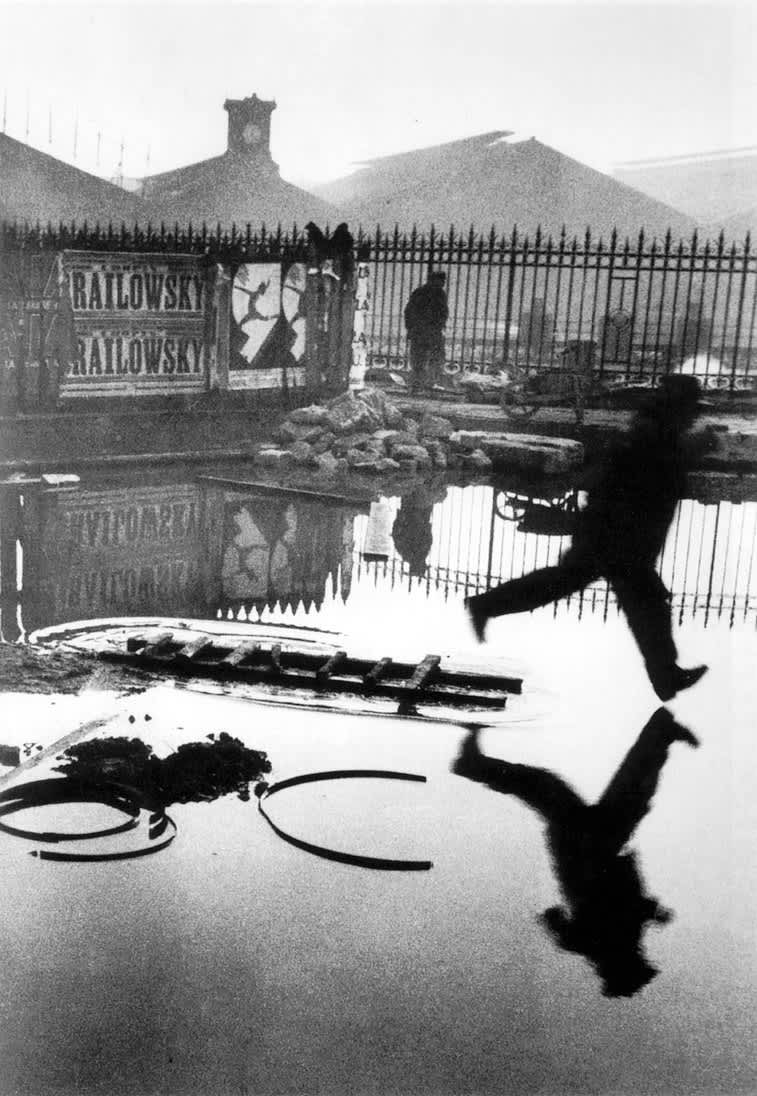Vox Populi
A curated webspace for Poetry, Politics, and Nature. Over 20,000 daily subscribers, 7,000 archived posts, 73 million hits and 5 million visitors.
Henri Cartier-Bresson: Behind the Gare Saint-Lazare, 1932

—
Behind the Gare Saint-Lazare is a black and white photograph taken by French photographer Henri Cartier-Bresson in Paris in 1932. The picture has variable dimensions, according to the different prints. It is one of his best known and most critically acclaimed photographs and became iconic of his style that attempted to capture the decisive moment in photography.
The image was captured spontaneously at the Place de l’Europe, outside the Saint-Lazare train station in Paris with his portable Leica camera: a man in mid-air leaping over wet ground with his shadow reflected beneath him. Behind him posters in a wall advertise dancers who echo the man’s movement, as well as the Railowski Circus. The man is forever framed in the air.
This was one of the few photographs that the artist cropped. Cartier-Bresson explained, “There was a plank fence around some repairs behind the Gare Saint-Lazare, and I was peeking through the spaces with my camera eye. This is what I saw. The space between the planks was not entirely wide enough for my lens, which is the reason the picture is cut off on the left.”
There are prints of this photograph at several public collections, including the Henri Cartier-Bresson Foundation, in Paris, the Museum of Modern Art and the International Center of Photography, both in New York, and the San Francisco Museum of Modern Art.
Early life of Henri Cartier-Bresson
Born in Chanteloup-en-Brie, France in 1908 to a wealthy textile merchant, Henri Cartier-Bresson was the eldest of five children. His mother, Marthe, exposed him to the arts including taking him on trips to the Louvre in Paris, attending chamber music concerts, and regularly reading him poetry. His father, Andre, was a severe man, consumed with the role of paternal duty and dedicated to his successful textile business. In response to his father’s defection to the world of business, Henri vowed at an early age never to follow in his father’s footsteps.
Accomplishments
- Cartier-Bresson’s work spanned photographic genres for the entirety of his long career. He is regarded as a pioneer of candid and street photography but he is also well-known for having produced some of the most compelling photographic portraits of notables ranging from Jean-Paul Sartre and Leonard Bernstein to Marilyn Monroe and Malcolm X. An early user of 35mm film, Cartier-Bresson preferred never to use the darkroom to adjust his photographs, a choice that enhanced the spontaneity of his images and emphasized what he called “the decisive moment.” No single photographer is more closely linked to the development of modern photojournalism than is Cartier-Bresson, whose itinerant nature brought him to some of the most momentous events and sites in modern history – from the liberation of Paris from Nazi occupation to the assassination of Mahatma Ghandi.
- To enhance his capacity to take the kind of candid shots he preferred, Cartier-Bresson often wrapped his Leica camera in black tape to make it less obtrusive. Assuming the role of the modern flâneur, his camera became an extension of his eye as he wandered, seeking visually, psychologically, and intellectually stimulating visual material. Ironically, while Cartier-Bresson could linger for hours observing, patiently awaiting the perfect shot, he was always poised to make the snap decisions required to seize a given moment to fix in time.
- In addition to still photography, Cartier-Bresson was an accomplished filmmaker, who first became interested in the medium when he worked with Jean Renoir. His filmography includes nearly ten films and he is regarded as an influential figure in the development of cinéma verité.
- Cartier-Bresson’s earlier inclination toward painting endured even after he stopped painting to pursue a long and fruitful career in photography. While he didn’t return to producing canvases actively until late in life, the formal training informed his photography, disciplined his eye, and compelled him not only to continue to cultivate relationships with the notable, avant-garde painters of his era but also to regard his own photographic style as a kind of nexus between painting and photography.
The Legacy of Henri Cartier-Bresson
Nothing captures the essence of Cartier-Bresson’s work more precisely than the concept of “the decisive moment.” Since its invention, the potential of photography had been debated and the divide between “art” and “documentary” photography seemed intractable. Combining his affinity for the disciplined painting of the great masters with his interest in Surrealism and modern philosophy plus his thirst for adventure and desire to be in the thick of current events, Cartier-Bresson used photography to create visual documents of remarkable spontaneity. As he refused to alter his images after snapping a photo, including foregoing cropping , while often artfully framed, seem to bring together the two possibilities of photography: art and visual documentation.
One of the versatile photographer’s greatest achievements was detaching himself from his reliance on magazines for commissions, which could be restrictive from a professional perspective. With commissions, artistic license was often quite constrained and subject matter was dictated by the nature of a given commission. Co-founding Magnum allowed him to continue his efforts at photojournalism but choosing his own subjects instead of accepting assignments; at the same time, he was then free to pursue photography for its artistic possibilities. Cartier-Bresson, who considered himself a photojournalist and is regarded as one of the true pioneers of street photography, was capable of producing acutely modern compositions. The variety in his oeuvre is vast; his career was in some ways one long experiment that inspired photographers as diverse as Helen Levitt, Robert Frank, Diane Arbus, and Lee Friedlander.
Text adapted from The Art Story. This post was curated by Michael Simms.
Information
This entry was posted on March 26, 2022 by Vox Populi in Art and Cinema, Most Popular, Opinion Leaders, Social Justice and tagged 1932, A father comforts his son on his deathbed. The photo that changed the face of AIDS (1989), Behind the Gare Saint-Lazare, Decisive moment, Diane Arbus, Helen Levitt, Henri Cartier-Bresson, Lee Friedlander, Masters of Photography, photojournalism, Robert Frank, street photography.Shortlink
https://wp.me/p4xqzG-hjgSearch
Search
Blog Stats
- 4,862,653
